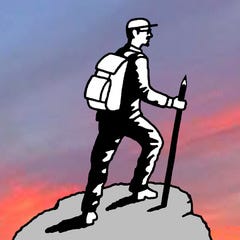Swiss Alpine cabins – a national treasure at risk
Our legendary mountain cabins: a microcosm of what we’re losing to climate change
Like many other Swiss, I owe some of my most formative experiences to the wonderful network of mountain cabins built and maintained by the Swiss Alpine Club (SAC): venturing up to the exposed Mischabel cabin with my brother and our dad as a little boy. Convincing my elderly mother to join me one more time for the stunning hike up to Tschierva cabin. Crossing majestic glaciers to reach the remote Mutthorn and Bordier cabins. Enjoying adventures, friendship and the simple life in numerous week-long treks from cabin to cabin. Introducing our son and many foreign visitors to the beauty of the Swiss Alps on spectacular hikes to these cabins.
The eternal beauty of the peaks and glaciers we enjoyed on such hikes often allowed me to leave my daily little worries behind. Except we now know that our addiction to fossil fuels is putting even these apparently eternal treasures at risk.
A new SAC study finds that climate change will affect its network of 152 cabins “to a large degree”. Thawing permafrost and retreating glaciers will potentially destabilize the foundations of 65 cabins (or 42% of the SAC’s network) by 2050. Rockfall and debris flow will threaten the access routes to 89 cabins (59%). The Mutthorn cabin, where I learned abseiling, already had to be closed because of such problems and is currently being rebuilt nearby.
Due to retreating glaciers and snow fields, 54 cabins (36%) may lose access to their sources of freshwater by 2050. Climate change will affect the hikes and climbs you can undertake from 130 cabins (86%), and the number of cabins accessible across glaciers will drop from 22 to six. While glaciers are still a dominating feature in the surroundings of many cabins today, you won’t see any permanent snow from 146 cabins by the end of the century, and only some minor left-overs from the remaining six.
I find it shocking that our kids will no longer be able to experience treasures which are part of our national heritage and which we have taken for granted for many generations. I’m also aware, however, that the changes affecting our cabins pale in significance with the threats which millions of people in other countries are facing. If the melting permafrost destabilizes hiking trails and huts in the Swiss Alps, it is also destroying millions of square kilometers of land in the arctic regions of Russia, Canada and Alaska. If receding glaciers will cut off 54 Swiss mountains cabins from their drinking water, they are also threatening the freshwater supply and livelihoods of hundreds of millions of people in the Indus, Ganges and Brahmaputra valleys.
The love for our mountains and cabins unites all groups of Swiss society. If the cabins are important for us, they are just a tiny microcosm of the havoc which climate change is wreaking around the world. Playing such a big role in our national identity, the Swiss Alpine Club has an influential voice and needs to sensitize the Swiss population about the wider risks of climate change.
PS. I am happy to introduce, along with this post, a fitting new logo which Res Rothacher has developed for the Swiss Climate Rambles blog. Res is an old friend who has shaped the look and feel of many important campaigns in Switzerland. Thank you!
Photo: Baltschieder cabin (copyright SAC). Imagine this cabin without a glacier!
Subscribe to my blog for free if you wish to see similar posts.





